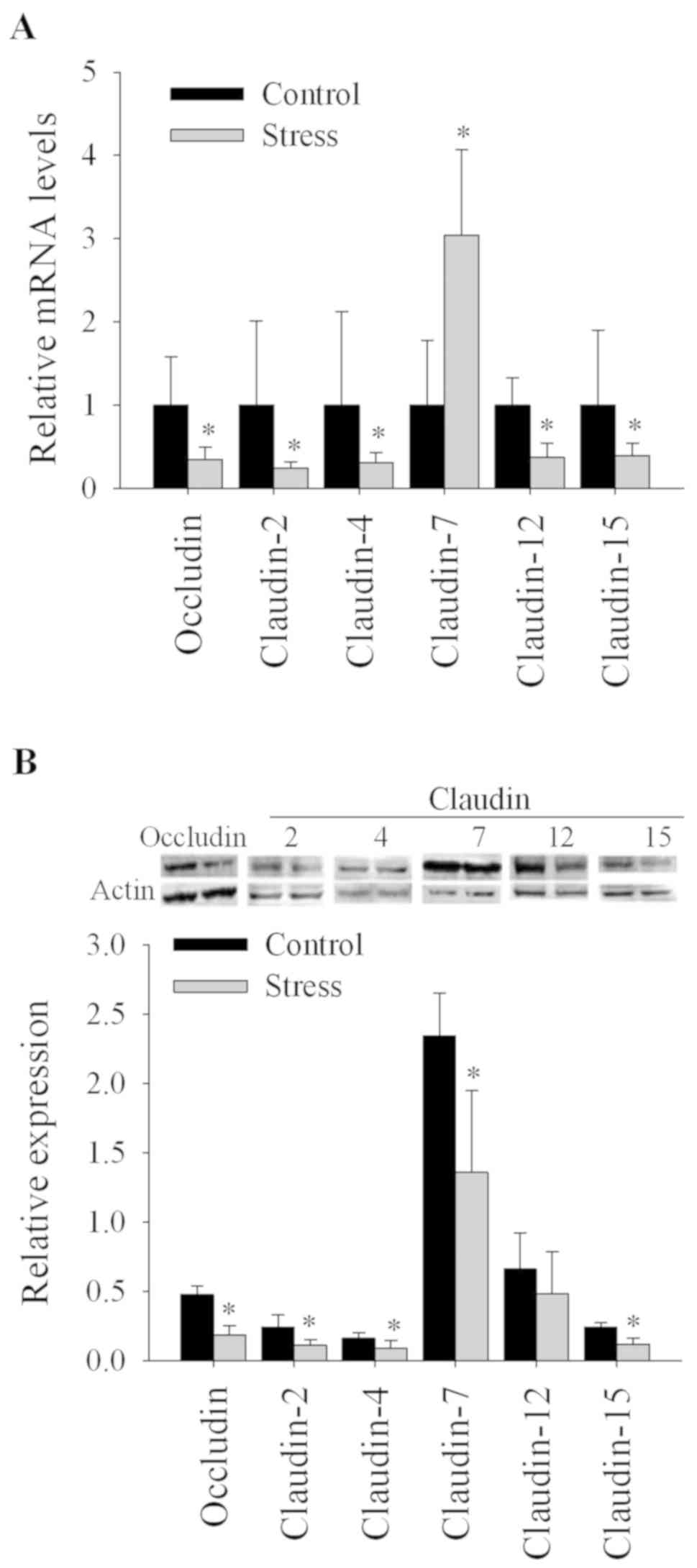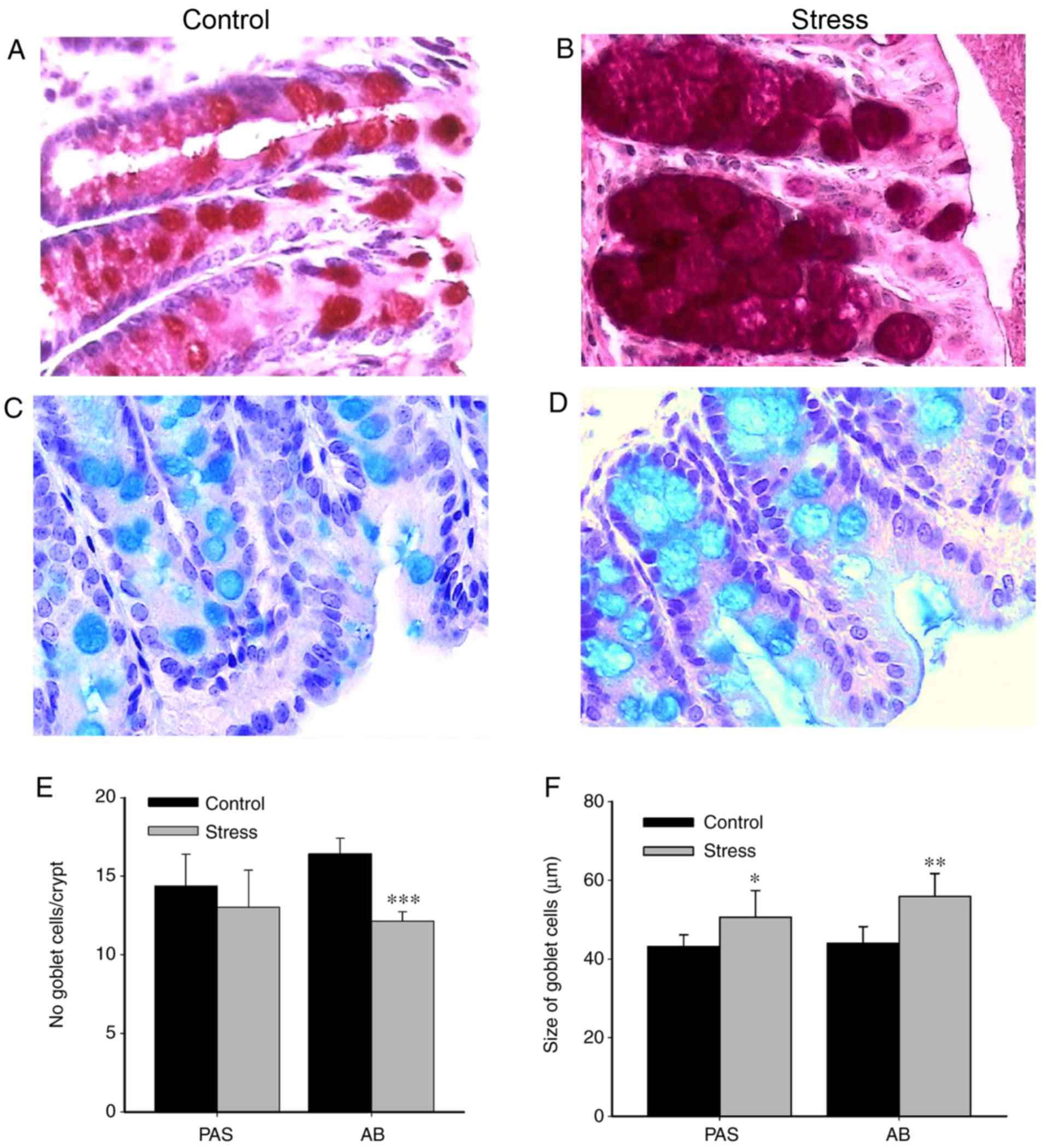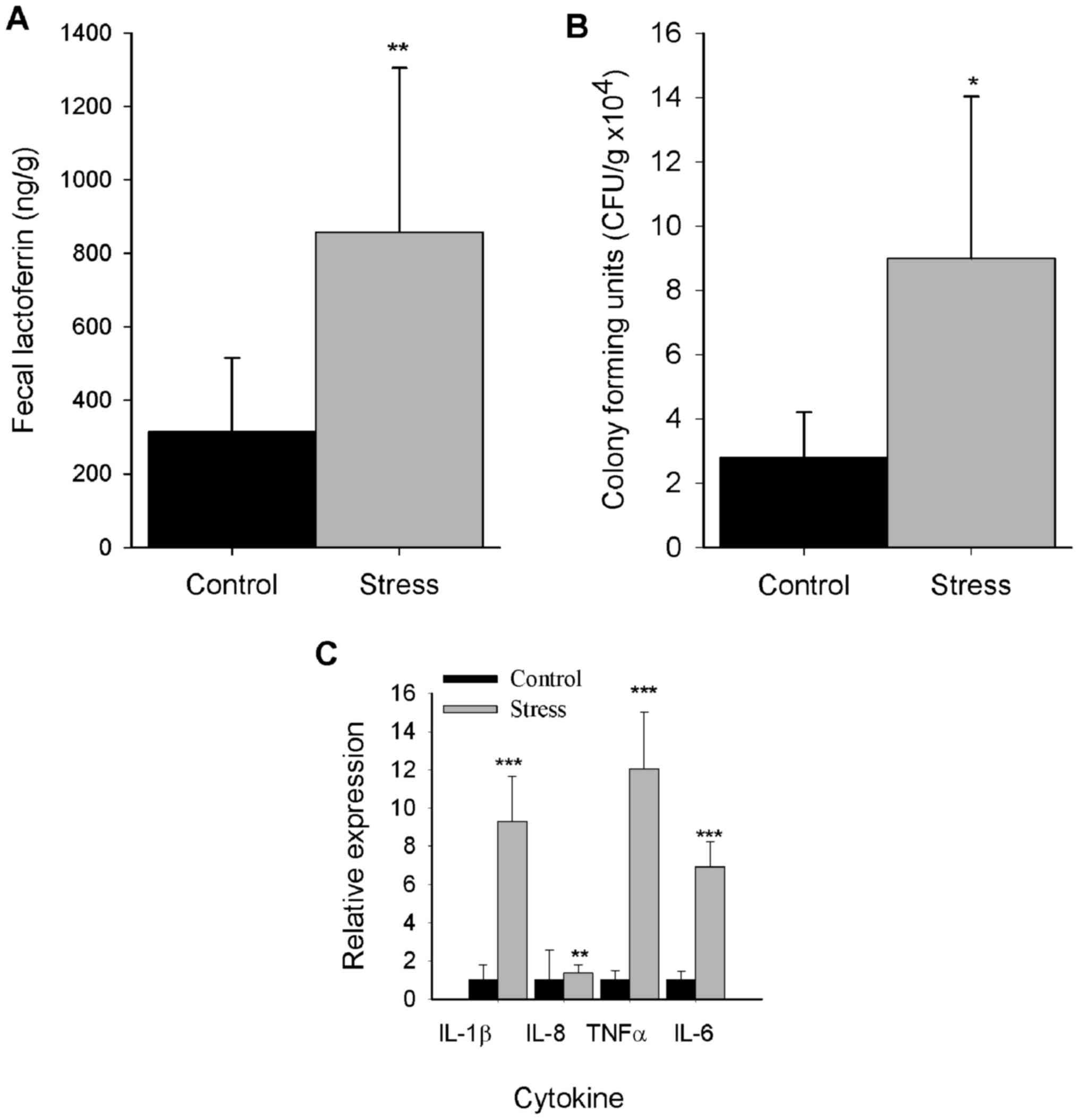|
1
|
Zhang K, Hornef MW and Dupont A: The
intestinal epithelium as guardian of gut barrier integrity. Cell
Microbiol. 17:1561–1569. 2015. View Article : Google Scholar : PubMed/NCBI
|
|
2
|
France MM and Turner JR: The mucosal
barrier at a glance. J Cell Sci. 130:307–314. 2017. View Article : Google Scholar : PubMed/NCBI
|
|
3
|
Turner JR, Buschmann MM, Romero-Calvo I,
Sailer A and Shen L: The role of molecular remodeling in
differential regulation of tight junction permeability. Semin Cell
Dev Biol. 36:204–212. 2014. View Article : Google Scholar : PubMed/NCBI
|
|
4
|
Fujita H, Chiba H, Yokozaki H, Sakai N,
Sugimoto K, Wada T, Kojima T, Yamashita T and Sawada N:
Differential expression and subcellular localization of claudin-7,
−8, −12, −13, and −15 along the mouse intestine. J Histochem
Cytochem. 54:933–944. 2006. View Article : Google Scholar : PubMed/NCBI
|
|
5
|
Holmes JL, Van Itallie CM, Rasmussen JE
and Anderson JM: Claudin profiling in the mouse during postnatal
intestinal development and along the gastrointestinal tract reveals
complex expression patterns. Gene Expr Patterns. 6:581–588. 2006.
View Article : Google Scholar : PubMed/NCBI
|
|
6
|
Inai T, Sengoku A, Guan X, Hirose E, Iida
H and Shibata Y: Heterogeneity in expression and subcellular
localization of tight junction proteins, claudin-10 and −15,
examined by RT-PCR and immunofluorescence microscopy. Arch Histol
Cytol. 68:349–360. 2005. View Article : Google Scholar : PubMed/NCBI
|
|
7
|
Faderl M, Noti M, Corazza N and Mueller C:
Keeping bugs in check: The mucus layer as a critical component in
maintaining intestinal homeostasis. IUBMB Life. 67:275–285. 2015.
View Article : Google Scholar : PubMed/NCBI
|
|
8
|
Bailey MT, Dowd SE, Parry NM, Galley JD,
Schauer DB and Lyte M: Stressor exposure disrupts commensal
microbial populations in the intestines and leads to increased
colonization by Citrobacter rodentium. Infect Immun. 78:1509–1519.
2010. View Article : Google Scholar : PubMed/NCBI
|
|
9
|
Cameron HL and Perdue MH: Stress impairs
murine intestinal barrier function: Improvement by glucagon-like
peptide-2. J Pharmacol Exp Ther. 314:214–220. 2005. View Article : Google Scholar : PubMed/NCBI
|
|
10
|
Reber SO, Peters S, Slattery DA, Hofmann
C, Schölmerich J, Neumann ID and Obermeier F: Mucosal
immunosuppression and epithelial barrier defects are key events in
murine psychosocial stress-induced colitis. Brain Behav Immun.
25:1153–1161. 2011. View Article : Google Scholar : PubMed/NCBI
|
|
11
|
Söderholm JD, Yang PC, Ceponis P, Vohra A,
Riddell R, Sherman PM and Perdue MH: Chronic stress induces mast
cell-dependent bacterial adherence and initiates mucosal
inflammation in rat intestine. Gastroenterology. 123:1099–1108.
2002. View Article : Google Scholar : PubMed/NCBI
|
|
12
|
Santos J, Yang PC, Söderholm JD, Benjamin
M and Perdue MH: Role of mast cells in chronic stress induced
colonic epithelial barrier dysfunction in the rat. Gut. 48:630–636.
2001. View Article : Google Scholar : PubMed/NCBI
|
|
13
|
Santos J, Yates D, Guilarte M, Vicario M,
Alonso C and Perdue MH: Stress neuropeptides evoke epithelial
responses via mast cell activation in the rat colon.
Psychoneuroendocrinology. 33:1248–1256. 2008. View Article : Google Scholar : PubMed/NCBI
|
|
14
|
Vicario M, Guilarte M, Alonso C, Yang P,
Martínez C, Ramos L, Lobo B, González A, Guilà M, Pigrau M, et al:
Chronological assessment of mast cell-mediated gut dysfunction and
mucosal inflammation in a rat model of chronic psychosocial stress.
Brain Behav Immun. 24:1166–1175. 2010. View Article : Google Scholar : PubMed/NCBI
|
|
15
|
Vicario M, Alonso C, Guilarte M, Serra J,
Martínez C, González-Castro AM, Lobo B, Antolín M, Andreu AL,
García-Arumí E, et al: Chronic psychosocial stress induces
reversible mitochondrial damage and corticotropin-releasing factor
receptor type-1 upregulation in the rat intestine and IBS-like gut
dysfunction. Psychoneuroendocrinology. 37:65–77. 2012. View Article : Google Scholar : PubMed/NCBI
|
|
16
|
Zheng G, Wu SP, Hu Y, Smith DE, Wiley JW
and Hong S: Corticosterone mediates stress-related increased
intestinal permeability in a region-specific manner.
Neurogastroenterol Motil. 25:e127–e139. 2013. View Article : Google Scholar : PubMed/NCBI
|
|
17
|
Hattay P, Prusator DK, Tran L and
Greenwood-Van Meerveld B: Psychological stress-induced colonic
barrier dysfunction: Role of immune-mediated mechanisms.
Neurogastroenterol Motil. 29:2017. View Article : Google Scholar : PubMed/NCBI
|
|
18
|
Lauffer A, Vanuytsel T, Vanormelingen C,
Vanheel H, Salim Rasoel S, Tóth J, Tack J, Fornari F and Farré R:
Subacute stress and chronic stress interact to decrease intestinal
barrier function in rats. Stress. 19:225–234. 2016. View Article : Google Scholar : PubMed/NCBI
|
|
19
|
Nébot-Vivinus M, Harkat C, Bzioueche H,
Cartier C, Plichon-Dainese R, Moussa L, Eutamene H, Pishvaie D,
Holowacz S, Seyrig C, et al: Multispecies probiotic protects gut
barrier function in experimental models. World J Gastroenterol.
20:6832–6843. 2014. View Article : Google Scholar : PubMed/NCBI
|
|
20
|
Official Mexican Standard
NOM-062-ZOO-1999, . Technical specifications for the production,
care and use of laboratory animals. Secretary of agriculture,
livestock, rural development, fisheries and Food (SAGARPA).
Official Gazette, Mexican Federal Government. June 18–2001.
|
|
21
|
Bhatia N, Maiti PP, Choudhary A, Tuli A,
Masih D, Khan U, Ara T and Jaggi AS: Animal models in the study of
stress: A review. NSHM J Pharm Healthcare Manage. 2:42–50.
2011.
|
|
22
|
Uni Z, Smirnov A and Sklan D: Pre- and
posthatch development of goblet cells in the broiler small
intestine: Effect of delayed access to feed. Poult Sci. 82:320–327.
2003. View Article : Google Scholar : PubMed/NCBI
|
|
23
|
Logsdon LK and Mecsas J: A non-invasive
quantitative assay to measure murine intestinal inflammation using
the neutrophil marker lactoferrin. J Immunol Methods. 313:183–190.
2006. View Article : Google Scholar : PubMed/NCBI
|
|
24
|
Xiao Y and Isaacs SN: Enzyme-linked
immunosorbent assay (ELISA) and blocking with bovine serum albumin
(BSA)-not all BSAs are alike. J Immunol Methods. 384:148–151. 2012.
View Article : Google Scholar : PubMed/NCBI
|
|
25
|
Livak KJ and Schmittgen TD: Analysis of
relative gene expression data using real-time quantitative PCR and
the 2(-Delta Delta C(T)) method. Methods. 25:402–408. 2001.
View Article : Google Scholar : PubMed/NCBI
|
|
26
|
Rozen S and Skaletsky H: Primer3 on the
WWW for general users and for biologist programmers. Methods Mol
Biol. 132:365–386. 2000.PubMed/NCBI
|
|
27
|
Kyoko OO, Kono H, Ishimaru K, Miyake K,
Kubota T, Ogawa H, Okumura K, Shibata S and Nakao A: Expressions of
tight junction proteins Occludin and Claudin-1 are under the
circadian control in the mouse large intestine: Implications in
intestinal permeability and susceptibility to colitis. PLoS One.
9:e980162014. View Article : Google Scholar : PubMed/NCBI
|
|
28
|
Liévin-L Moal V and Servin AL: The front
line of enteric host defense against unwelcome intrusion of harmful
microorganisms: Mucins, antimicrobial peptides, and microbiota.
Clin Microbiol Rev. 19:315–337. 2006. View Article : Google Scholar : PubMed/NCBI
|
|
29
|
Siddiqui I, Majid H and Abid S: Update on
clinical and research application of fecal biomarkers for
gastrointestinal diseases. World J Gastrointest Pharmacol Ther.
8:39–46. 2017. View Article : Google Scholar : PubMed/NCBI
|
|
30
|
Sandrini SM, Shergill R, Woodward J,
Muralikuttan R, Haigh RD, Lyte M and Freestone PP: Elucidation of
the mechanism by which catecholamine stress hormones liberate iron
from the innate immune defense proteins transferrin and
lactoferrin. J Bacteriol. 192:587–594. 2010. View Article : Google Scholar : PubMed/NCBI
|
|
31
|
Al-Sadi R, Khatib K, Guo S, Ye D, Youssef
M and Ma T: Occludin regulates macromolecule flux across the
intestinal epithelial tight junction barrier. Am J Physiol
Gastrointest Liver Physiol. 300:G1054–G1064. 2011. View Article : Google Scholar : PubMed/NCBI
|
|
32
|
Ponferrada A, Caso JR, Alou L, Colón A,
Sevillano D, Moro MA, Lizasoain I, Menchén P, Gómez-Lus ML, Lorenzo
P, et al: The role of PPARgamma on restoration of colonic
homeostasis after experimental stress-induced inflammation and
dysfunction. Gastroenterology. 132:1791–1803. 2007. View Article : Google Scholar : PubMed/NCBI
|
|
33
|
Iraha A, Chinen H, Hokama A, Yonashiro T,
Kinjo T, Kishimoto K, Nakamoto M, Hirata T, Kinjo N, Higa F, et al:
Fucoidan enhances intestinal barrier function by upregulating the
expression of claudin-1. World J Gastroenterol. 19:5500–5507. 2013.
View Article : Google Scholar : PubMed/NCBI
|
|
34
|
Nevado R, Forcén R, Layunta E, Murillo MD
and Grasa L: Neomycin and bacitracin reduce the intestinal
permeability in mice and increase the expression of some
tight-junction proteins. Rev Esp Enferm Dig. 107:672–676. 2015.
View Article : Google Scholar : PubMed/NCBI
|
|
35
|
Koh SJ, Kim JW, Kim BG, Lee KL and Kim JS:
Restraint stress induces and exacerbates intestinal inflammation in
interleukin-10 deficient mice. World J Gastroenterol. 21:8580–8587.
2015. View Article : Google Scholar : PubMed/NCBI
|
|
36
|
Kim JJ and Khan WI: Goblet cells and
mucins: Role in innate defense in enteric infections. Pathogens.
2:55–70. 2013. View Article : Google Scholar : PubMed/NCBI
|
|
37
|
Bourke CH, Harrell CS and Neigh GN:
Stress-induced sex differences: Adaptations mediated by the
glucocorticoid receptor. Horm Behav. 62:210–218. 2012. View Article : Google Scholar : PubMed/NCBI
|
|
38
|
Grishina I, Fenton A and Sankaran-Walters
S: Gender differences, aging and hormonal status in mucosal injury
and repair. Aging Dis. 5:160–169. 2014.PubMed/NCBI
|
|
39
|
Andrews C, McLean MH and Durum SK:
Cytokine tuning of intestinal epithelial function. Front Immunol.
9:12702018. View Article : Google Scholar : PubMed/NCBI
|
|
40
|
Cakir B, Bozkurt A, Ercan F and Yeğen BC:
The anti-inflammatory effect of leptin on experimental colitis:
Involvement of endogenous glucocorticoids. Peptides. 25:95–104.
2004. View Article : Google Scholar : PubMed/NCBI
|
|
41
|
Rijnierse A, Koster AS, Nijkamp FP and
Kraneveld AD: TNF-alpha is crucial for the development of mast
cell-dependent colitis in mice. Am J Physiol Gastrointest Liver
Physiol. 291:G969–G976. 2006. View Article : Google Scholar : PubMed/NCBI
|
|
42
|
Camilleri M, Sellin JH and Barrett KE:
Pathophysiology, evaluation, and management of chronic watery
diarrhea. Gastroenterology. 152:515–532.e2. 2017. View Article : Google Scholar : PubMed/NCBI
|
|
43
|
Lapointe TK and Buret AG: Interleukin-18
facilitates neutrophil transmigration via myosin light chain
kinase-dependent disruption of occludin, without altering
epithelial permeability. Am J Physiol Gastrointest Liver Physiol.
302:G343–G351. 2012. View Article : Google Scholar : PubMed/NCBI
|
|
44
|
Ananthakrishnan AN: Environmental triggers
for inflammatory bowel disease. Curr Gastroenterol Rep. 15:3022013.
View Article : Google Scholar : PubMed/NCBI
|
|
45
|
Konturek PC, Brzozowski T and Konturek SJ:
Stress and the gut: Pathophysiology, clinical consequences,
diagnostic approach and treatment options. J Physiol Pharmacol.
62:591–599. 2011.PubMed/NCBI
|

















